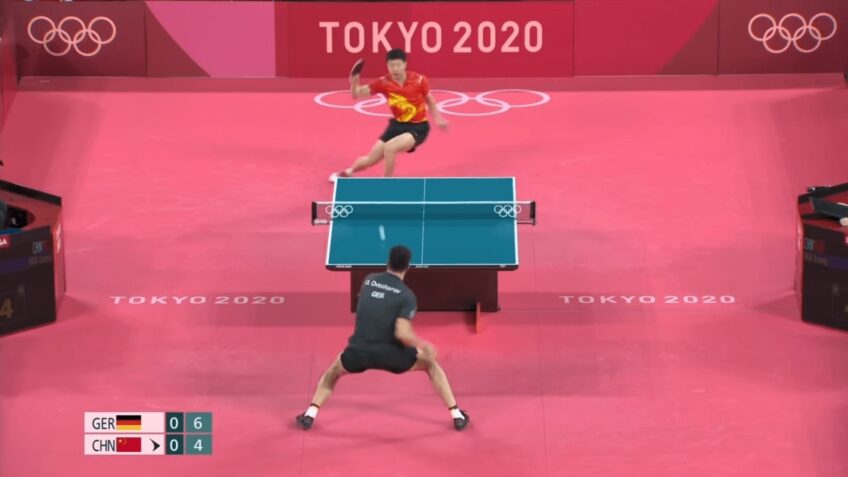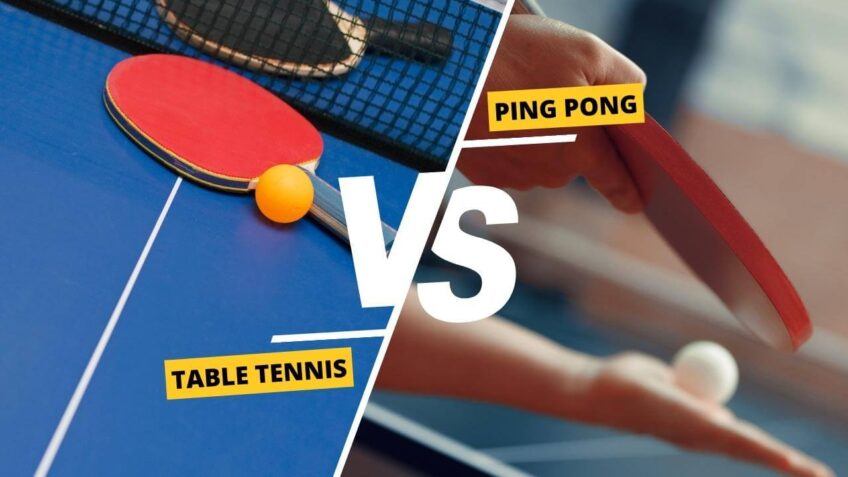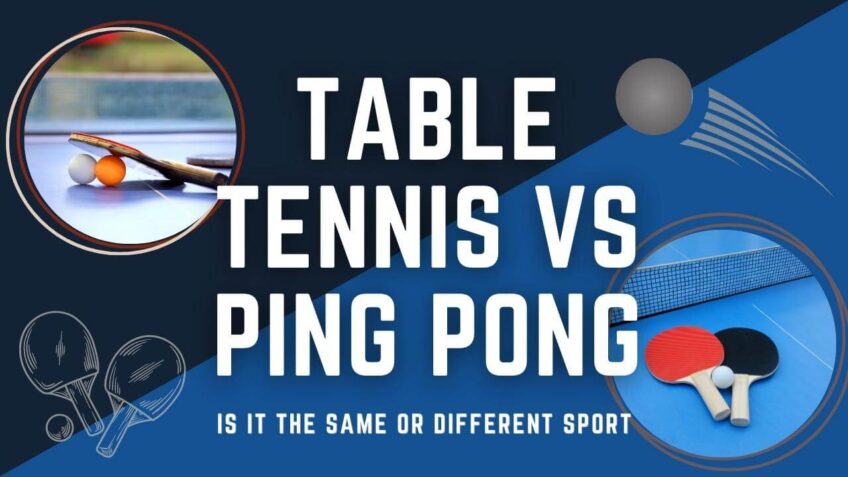Do you ever wonder if Table Tennis and Ping Pong are the same sport? Have you ever been confused about their differences? Get ready to learn the truth behind this age old debate. You’ll be sure to know exactly how these two sports differ after reading this article!
Table tennis and ping pong are two sports that can be easily confused due to their similar names and apparent closeness in the family of racquet games. Although they are related, the terms “table tennis” and “ping pong” refer to different types of games, competitively as well as recreationally. To understand their differences, it’s important to look at their histories, playing styles, equipment regulations and Olympic recognition.
Table tennis is the enhanced version of ping pong that has its own international body or governing authority known as the International Table Tennis Federation (ITTF). The sport originated in England approximately 200 years ago and began to attract attention when players improvised by using padded paddles on a regular table. Playing informally almost immediately shifted into a more organized sport played competitively by elite players globally with standardized components including tables, nets and rackets.
In contrast, ping pong is a recreational sport that does not have an international body that oversees it. Its name was derived from a trademark used by an English firm called JD Hinged&Co during the late 1800s for one of its products called Table Tennis; but over time this came to be known as ping pong instead.
The 2 key differences between table tennis and ping pong are due to its playing environment – either social or professional – and its governing body which organizes official tournaments worldwide for table tennis only excluding all other forms of racket sports from the competition.
History of Table Tennis
Table Tennis is thought to have originated in England during the Victorian era. It is believed that it was derived from a popular game called “Royal Tennis” and started out as a family game.
In 1891, the Table Tennis Association was established in England and the first rules were laid down in 1893. Over time the popularity of the game spread to other countries and eventually was standardized by several international organizations.
In 1902, a Swedish bookseller named Hamley commercially introduced table tennis into the United States, selling sets at a reduced price to promote his business.
The name “Ping Pong” wasn’t introduced until much later after manufacturers started producing equipment bearing that brand name and it became very popular in bars, pool halls, arcades, and amusement centers during WWII.
By 1952 table tennis had become an official Olympic sport with over 10 million players worldwide. Today, there are over 40 million players and Ping Pong or Table Tennis continues to be one of the most popular sports across many countries all around the world.
History of Ping Pong
The sport known as Ping Pong, the recreational game popularized around the world, actually began back in the 1800s. It is believed that a combination of sports including tennis, badminton, and squash was organized into a livelier version of table tennis that was suitable for small parlors and dens.
The game grew in popularity in England over the years along with similar versions of miniature tennis-like games played on tables. A manufacturer of sporting goods created a variety of popular paddles and balls with rubber surfaces, which probably encouraged further play. Thus began the modern variant referred to as Ping Pong.
Although it remains a casual pastime in some countries, in other areas like China, Korea and Japan; table tennis has become an important part of physical fitness programs along with badminton and martial arts forms like judo and karate. In fact, professional table tennis tournaments are now held yearly based on international associations established to govern rules.
In 1972 table tennis became an official Olympic sport with singles events for men and women and doubles events for men, women and mixed players representing teams from all over the world. Since then technology has continued to develop better racket material including composite materials like graphite that provide superior speed and control during serve returns or in quick exchanges at midcourt goals due to superior spin dynamics between rubber sheets placed on each side of thin wooden frames or rackets.
Main Differences

Table tennis is an Olympic sport and there are many different protocols and regulations that govern it. The equipment used in this variant of the game differs from traditional ping pong equipment due to stricter manufacturing standards, with a larger and thicker net, a heavier ball with a larger diameter and an increased speed limit on the ball’s trajectory across the table.
The rules for table tennis also differ from those of recreational ping pong and include regulations such as:
- Point-serving turns
- Number of serving attempts
- Time limits between serves
- Length of time players can take breaks between games or sets
- Maximum score limit per match or set
Although recreational ping pong makes use of many standard qualities defined in ITTF rules, such as playing on either side of a net or using paddles to hit a hollow rubber ball over that net, there may be exceptions to these basic concepts within certain groups or circles who play under specific house rules which may differ from official ITTF guidelines.
Other aspects such as paddle design and material used for balls can also differ within certain circles despite all conforming to general international guidelines regarding size shape weight etc. Similarly, some aspects like court size time limits per round types of spin services etc may not conform strictly with ITTF regulations but may be right within particular social circles since social versions place greater emphasis on entertainment rather then precision-based rules defined by international governing bodies.
Rules of Table Tennis
Table tennis is governed by the International Table Tennis Federation (ITTF) which sets the rules and regulations for it.
To play a full game of table tennis, two players or four players, if playing doubles, hit the small light-weight ball back and forth over a net on a hard table divided by a center line. This ball can be made from various types of material including celluloid, plastic and foam polystyrene.
Points are scored when one player fails to return the ball to the other side of the net either due to an inability to reach it or hitting it out of bounds. A match is typically best 3 out of 5 games with each game being won by whoever scores 11 first or varies for higher level matches and tournaments.
When playing competitively-sanctioned table tennis, various rules must be adhered to including:
- Proper dress attire (players must wear “proper sports apparel”).
- Court layout (the distance between tables should vary depending on age/level).
- Personal hygiene (each player must have their own towel).
- Sportsmanship/ethics (respectful conduct at all times).
Rules of Ping Pong
Though Table Tennis and Ping Pong are sometimes used interchangeably, each game has different rules. Below are some of the rules and regulations governing the sport:
- A match consists of three games and a player must win two out of the three games to win the match.
- The serving racket must strike the ball while it is still bouncing on the side of the table.
- The ball must pass over or around the net into the opponent’s half of the table after being bounced and before it bounces twice on their side.
- The server must let go of their racket before striking the ball, which has to be below 16cm (6 inches) above then table at all times during play.
- The surface on either side halves have markings that determine where players stand while serving and returning.
- Returns that hit either portions of surface, edges, net or posts are considered invalid unless they were originally served from their opponent’s court.
- Players can only serve one point in a match at a time.
- A typical point is won when a player fails to return an incoming shot or hits his/her own part of the court.
Professional Table Tennis vs Professional Ping Pong

When it comes to professional-level play, the terms Table Tennis and Ping Pong refer to the same sport. Professional table tennis players compete in a fast-paced game of wits and racquet technique. Players use specialized rackets designed for high speed and control to return serves from their opponents. To win a point, a player must hit the ball over the net, so that their opponent(s) cannot return it before it bounces twice on their side of the court.
Unlike in recreational ping pong, where players utilize any kind of paddle or racket they can find, professional players use rackets specifically made for Table Tennis which are typically lighter and denser than ordinary paddles. Players must also adhere to strict regulations regarding uniform appearance and dress code when playing competitively.
In addition to these differences in equipment, professional table tennis has an extensive set of rules that regulate gameplay not found in recreational ping pong. This includes regulations on:
- Serves (the person who begins each point)
- Lets (the occasional replay due to unexpected events like an outside disturbance)
- After-point etiquette (rules for how long a player can take per point)
- Hand signals used by referees during match play.
These subtle but essential distinctions between ping pong and table tennis demonstrate how much more complex the sport becomes when played at a high level. It is through this nuance that professional table tennis earns its place as one of the world’s most exciting sports!
Conclusion
In conclusion, while Table Tennis and Ping Pong are often used interchangeably, they are actually two different sports. Table Tennis is an internationally recognized sport created by the International Table Tennis Federation (ITTF). It is a game that incorporates lots of footwork, hand-eye coordination and strategy.
Ping Pong on the other hand, does not have as many rules and regulations compared to Table Tennis. It is more casual and can be played indoors or outdoors with no specific equipment needed to play the game. Both sports are fun, but one must understand the difference between them to truly enjoy either one.

